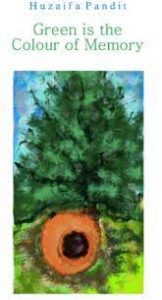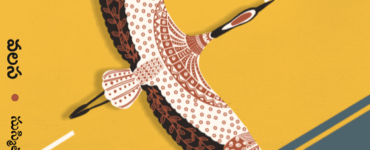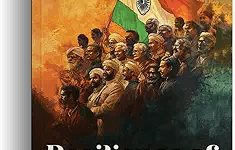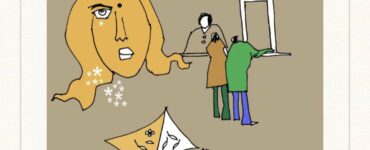You will ask why his poetry
doesn’t speak to us of dreams, of the leaves,
of the great volcanoes of his native land?
Come and see the blood in the streets,
come and see
the blood in the streets,
come and see the blood
in the streets! (Pablo Neruda, ‘I Explain Somethings’)
I first came across Huzaifa Pandit’s poems when he won the Rhythm Divine Poets initiated poetry chapbook contest in 2017. Procuring that slim volume of poems a year later, I was drawn by the depth of his writings. This young, sensitive, and lyrical poet from Kashmir brings out the angst of survival that living there involves. In a casual chat he once remarked, “you cannot understand Kashmir if you do not live here” and it is this weight of understanding and expression that his poetry carries. Mastering the dual qualities of compassion and protest, he evokes in his poetry a unique sensibility that does not lose the aesthetics even while dissenting. He sings, laments, dissents, celebrates, but all with a poise that is unique to the gharana of the Urdu poets of Kashmir. He has imbibed the lyricism of the Urdu language and infused the English language with it. His poems have a mellowness audible in ghazals –
“I grieved over her exiled grief
sketched in sudden tears and sullen eyes.
I bookmarked the page with a tired sigh and play a ghazal by Zafar.
Will someone light a candle in the sovereign’s defeated memory on a modest grave in a foreign-land.” (Imaginary Homelands)
Living in a land popularly exoticized as Paradise on earth yet confronting loss, death, anxiety, and suppression in actual living, Huzaifa archives life as he has experienced it and somewhere that connects him with all those people across the world fighting for peace and dignity in their homelands.
“We will evacuate our grief
Won’t you rent our empty hearts?
We will forsake our creed
Won’t you be the Prophet of heresy?” (Testimony in February)
He is the crusader for the homeless, for those seeking their identity. Through a uniquely Kashmiri lens, he presents a universal desire for one’s home and a safe night’s sleep that can also be connected to the agonizing experiences of the exiles of Syria or the displaced Rohingyas or the more recent oppressions in Afghanistan – “We have abandoned our homes/ Won’t you house us in mirrors of history?” (Testimonies in February)
The personal and the political merge in his poems as he becomes the spokesperson of the collective trauma that ravages his homeland. In speaking of love and longing, he also speaks of loss and resistance
“We were two, and yearned to be one, stranger. Walk to the river, east
of the book of promised massacres, and swim in the mirrors of our longing.
You may find our red sky of water, and the gods ground to dust standing guard
on the graves of our glass maps.” (https://boundindia.com/we-were-two/ )
In this month’s column of Poetspeak, we have with us this dynamic poet from Kashmir, Huzaifa Pandit discussing his poetics, the formative influences on his poetry, his aesthetics, and so on. As in his poems, so in addressing the questions, Huzaifa is deeply evocative. His homeland becomes the central metaphor of his works as he negotiates with the collective trauma as well as the personal ones. In the repertoire of English poetry from India, he is definitely an important voice to reckon with.

NS: Let us begin the conversation by trying to comprehend what your understanding of poetry is?
HF: This is a difficult question to answer for there is no one way to explain what my understanding of poetry is. Nonetheless, if I were pressed to answer this question, I would suggest that poetry may be understood as a form of expression that permits one to evade the limits of speech and perception and create alternate archives of possibilities. By subverting and transcending these limits, poetry offers a remedy to bypass restrictions of sense and sensibility, it charts unmapped territories that are rooted in the time and circumstances in which one writes, yet at the same time acquires a universality and timelessness that allows it to be meaningful across various times and geographies. This is not to claim that poetry is universal and timeless in the sense they were supposed to be embodied in canonical (colonial) poems. Rather, I mean to imply that even poetry that is rooted in specific exigencies can transcend these limits, and be relevant in other contexts. Warsan Shire’s poem ‘Home’ and particularly the line, ‘home is the mouth of a shark’, is relevant and captures accurately why I or many people of my generation or younger to me left home or try to leave home because home is a place of lingering fear, anxiety, and trauma. It speaks not just of Somalia but also of people in say Sri Lanka or Syria or Balochistan or even Mexico for that matter cutting across times, and locales.
NS: In your poems, you speak about Kashmir. How much of your poetry is shaped by the place of your belonging?
All of my poetry is shaped by Kashmir. Remove Kashmir from my poetry and very little will be left of it. Were there no Kashmir, I don’t think I would have turned to poetry. What would I have written about that has not been written about by others? I write because there is little else to do in Kashmir except feel helpless and mourn. Because one has to earn a livelihood as well as live a life, and the world must go on, one has to find alternate means to commemorate and mourn. Poetry offers a medium to do that, and so I write as others do too. It is as Ibn-e-Insha says, a line I quote often: Deewano.n ki sin a baat karay/ tau aur karay deewana kya? I live in Kashmir, so what else must a Kashmiri talk about? What else is a Kashmiri permitted to talk about or notice?
NS: Talking about poetry, what is your earliest experience of writing poetry? Any childhood memories associated with it?
HF: The earliest experience of writing poetry was in middle school – I think in grade 6th or 7th. I had maintained a journal of sorts – a plain notebook draped with gift wrapping paper. I had penned a few write-ups on very generic themes, which I believed, at that time, to be poems and essays. They were of course just juvenile attempts and I remember very little of them except the first couplet of a ‘poem’ on ‘Life in Hills’: “Life in the hills is a treat/as the people are very sweet.” I think this phase lasted only a couple of months, as an uncle, to whom, I recited the poem gave a most discouraging appraisal of it, as he thought people who dwell in hills were rather dishonest, and far from sweet.
NS: Many of your poems contain lines from past masters like Faiz, Khatir Gaznavi, Nasir Kazmi, and others. It is like a legacy that you are carrying forward. Where do you see yourself in this continuum of poets and how much do they influence your poetry?
I am not sure about the legacy aspect of it, as I am not convinced, I have evolved to that stage in my poetry where I can shoulder the burden of the immense legacy they have bequeathed. As Faiz said once when asked about friendship with Neruda: Dosti kay tau main dawaa nahee karsakta, yeh tau khaak aur zaat wali baat hui (I can’t claim friendship, it is like comparing dust to a god). So, the question of me being in a continuum doesn’t really arise. However, since I have and continue to read (and listen to) more Urdu poetry (and to some extent Kashmiri poetry) than poetry in English, the references to the works of past masters inevitably show up in my work. My fascination with poetry, which led me to pursue a PhD on it began with listening to and reading Urdu poetry especially the progressive poets, and then modern poets like NM Rashed or Amjad Islam Amjad. In my early twenties, I barely read anything other than Urdu poetry and used my time to rediscover poems which I had heard my grandfather or father hum on the Internet. It was such a preoccupation that I completely ignored my graduation, and didn’t bother with it for about three years, and as a result, completed it in five years.
Further in my MA, we studied Feminist Writing, Post-Colonial Writing, and Queer Writing, all of which had selections of Urdu poetry. Then for my Ph.D I chose to work on Faiz Ahmed Faiz among others which necessitated a detailed reading of not just his poetry, but also his contemporaries to situate him. Naturally, studying Urdu poets over the years has left its mark on me, as I find it easier to react in Urdu poetry to situations in routine life – hence the references. Moreover, during my Ph.D I realized that Agha Shahid Ali also employed lines from poets of other languages like the polish poet Zbigniew Herbert in his poems. Hence, I felt encouraged to use this strategy.
I also feel it is useful to forge our own aesthetic and expression that will set us apart from the mainstream Indian English poetry scene, which is by and large far removed from the concerns which occupy us. For example, in most collections, I find poems about sex and desire, or ennui, which rarely make a mention in poetry from Kashmir. Not that Kashmiris don’t experience these phenomena, but there is little time to dwell on them as our subjecthood is shaped by trauma, violence, and grief and poetry stems from an impulse to commemorate this loss. Urdu and Kashmiri poetry is very useful in this context since the ambit of experience it includes is closer to our realities and culture in general.
NS: Even when you speak of oppression, deaths, violence, and trauma, there is a musicality in the diction. Is this an influence of the Urdu poetry tradition which has some of the most lyrical poems of protest?
HF: To an extent yes. As I explained above, I started with reading Faiz and other progressive poets like Faraz or Jalib. Their influence remains to this day. One other reason is the influence of my Ph.D dissertation where I argued that the mapping of resistance poetry must be revised to include what Faiz called ‘political lyricism’. I had already read Faiz and a bit of Shahid before I embarked on my PhD, but it was the study of Darwish that convinced me that protest need not be at the cost of lyricism or rhythm. It is a constant endeavour and hopefully, it will reflect in some degree in my work.
NS: I keep reading your translations of Urdu poets on social media and they are extremely beautiful. What is it that prompts you to translate these poems? How important do you think is translating poetry?
HP: I have explained the rationale for translating in detail in an academic paper ‘Translating Loss – Translation as Resistance Literature’ (https://digitalcommons.macalester.edu/cgi/viewcontent.cgi?article=2597&context=himalaya) where I said: “translation can serve as an invaluable tool to illustrate the subjectivities produced under conflict.” In simpler words, translation is a way to comment on the routines and routes of loss and defiance. I am primarily interested in how the work speaks to me about a particular moment e.g., Khatir Gaznawi’s ghazal kaisi chali hai ab kay hawa teray shehar main appears to me to be particularly accurate in lamenting the loss of leadership in Kashmir, and the country at large as the agenda and fate of the people is at the mercy of a select few and hence ‘Men pass off as gods/in your city.. as a breeze laden with regret and anxiety pervades the cities of the nation.
How important is translating poetry?
I would say quite important. As the translation theorist Itman-Zohar proposed, literatures are a part of polysystems and borrowing can enrich the literature which exists at the margins. Political considerations aside, translation can be a useful exercise for poets. Not only does it help with writing blocks – you can still translate even if you struggle to come up with your own writing, but also provides you with fresh ideas and newer possibilities – one can learn a new metaphor or a new turn of phrase that can spark a poem in one. Besides struggling and negotiating with a poetic text, and trying to transfer it into another language helps build your sense of rhythm and structure.
NS: Talking of social media, what role do you think it plays in the contemporary poetic scenario?
HP: I am a social media poet. Where would you have heard of me unless social media were there? I owe everything to social media – all my publications. My audience is primarily on social media and most of the publication opportunities that have come my way have been due to social media. I advanced my example because it provides an excellent idea of the role of social media – it levels the playing field and gives you a ready-made audience. One need not be dependent on the whims of festival curators or invites to read one’s work. Moreover, social media is a liminal space – it defies boundaries and restrictions, and so builds a sense of collectivity that is important for poetry.
Speaking of Kashmir, particularly, it owes its literary renaissance that has bloomed since 2010 onwards, to social media. It was on Facebook that poets and other literary-minded people networked with each other, sharing and commenting on each other’s work and inspiring others to follow their lead. Gradually journals came up which rely on social media reach for seeking contributions and their audiences. Wande, Kashmir Lit, Mountain Ink, Inverse, and others would be dysfunctional without social media to back them up.
NS: Any future project that you have in mind and would like to share with the readers?
HP: My next book of poems: ‘….. and we left behind a brief memoir’ is coming next year inshallah.
*









Overwhelmed by the natural submission of a wonderful Poet along with the unique questions.
Thank you.